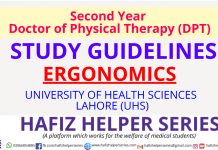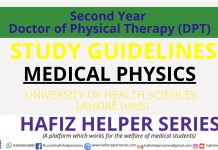Guidelines for Physiology is available for DPT , MBBS & Other Medical Fields
Physiology Guidelines for First Year (DPT, MBBS, BDS)
Guidelines from : Guyton & Hall
Physiology Guidelines
Recommended book is Guyton.
(*** shows UQs while ** &* shows importance of topic)
All these guidelines are according to UHS Syllabus
Chapter no. 1
• Negative feedback ***
• Gain of control system
• Positive feedback*
Chapter no. 2 (imp chap. don’t skip this chap)
• Cell membrane***
• Integral and peripheral proteins***
• Gylcocalyx***
• Functions of ER***
• Difference between lysosomes & peroxisomes***
• Endocytosis***
Chapter no. 3
Give one read only to this chap.
• Apoptosis*
• Why do cancer cells kill?
Chapter no. 4 (imp chap. Don’t skip anythjng)
• Diffusion vs active transport
• Fig. 4.1
• Diffusion of water & other lipid insoluble molecules through protein channels***
• Gating of protein channels***
• Facilitated diffusion requires membrane carrier proteins
• GLUT 4***
• Active transport***
Chapter no. 5 (imp chap. Don’t skip anything)
• Resting membrane potential***
• Action Potential***
• Chronaxie and its significance***
• Rheobase*
• Fig. 5.6 & fig. 5.7***
• Why Ca++ channels are called slow channels?
• All or none law**
• Propagation of action potential
• Importance of energy metabolism***
• Saltatory conduction***
• Absolute refractory period***
• Membrane stabilizing factors***
Chapter no. 6 (imp chap. Don’t skip anything)
• Figure 6.3***• General mechanism of muscle contraction***
• Sliding filament mechanism**
• Walk along theory***
• ATP as energy source ***
• Fenn effect*
• Fig. 6.9
• Energetics of muscle contraction***
• Isometric muscle contraction***
• Fast vs slow muscle fibers***
• Summation***
• Staircase effect
• Muscle tone*
• Muscle fatigue*
• Rigor mortis**
• Muscular Dystrophy***
• Neurotrophins***
Chapter no. 7 (imp chap. Don’t skip anything)
• Figure 7.1 & fig. 7.2 ***
• Fig. 7.4***
• End plate potential***
• Myasthenia gravis (scenario based question)***
• Lambort-Eaton syndrome (scenario based question)***
• Drugs that stimulate or inhibits neuromuscular junction
• Excitation contraction coupling**
Chapter no. 8
• Difference between types of smooth muscle***
• Comparison of smooth and skeletal muscle***
• Latch mechanism**
• Stress relaxation & reverse stress relaxation*
• Fig. 8.3 & fig. 8.5*
• Fig. 8.7
Chapter no. 9 (imp chap. Don’t skip anything)
• Action potential in cardiac muscle*
• Fig. 9.4**
• Refractory period of cardiac muscle***
• Cardiac cycle**
• Fig. 9.4*** (don’t skip this at any cost. Do every detail of it)
• Pressure changes in atria (blue box)
• Function of ventricles as pump
• Ejection fraction***
• Fig. 9.9**
• Preload and afterload*
• Frank Starling mechanism***
• Control of heart by sympathetic and parasympathetic nerves***
• Fig. 9.14
Chapter no. 10 (imp chap)
• Mechanism of self excitation of sinoatrial nodal fibers***
• Steps involved in spread of electrical impulses through heart***
• Fig. 10.2**
• Fig. 10.3*
• Atrioventricular node delay***
• Fig. 10.4 (mcqs)
• Stokes-Adams syndrome (detail is mentioned in ch13)
• Ventricular escape (detail is mentioned in ch 13)
Chapter no. 11 (imp chap)
• Fig. 11.1 (don’t skip this. Memorize all the values and def related to this)***
• P-R interval & Q-T interval**
• ECG leads ( read it)
• Enthoven’s triangle*
Chapter no. 12 ( just do topics which I mention below. Don’t skip these topics)
• Mean electrical axis of the normal ventricles is 59°
• Bundle branch block
• Right and left axis deviation*
• Current of injury*
• J point**
• ECG changes in hyperkalemia, hypokalemia, hypercalcemia, hypocalcemia*
Guidelines for DPT 1st year : Kinesiology
Chapter no. 13
• Bradycardia & Tachycardia
• Heart blocks & degrees of heart block*
• Ventricular fibrillation*
• Atrial flutter & fibrillation*
(I will recommend u to make short notes of this chap because too much detail is mentioned and u
don’t need to read complete chap again & again)
Chapter no. 14
Read this chap for basic concept of circulation
(Circulation starts from this chap. I did only UQs from guyton and did complete circulation from firdaus. I
did only circulation from firdaus. You can do circulation from dr. Hamid notes).
Chapter no. 15
• Arterial pressure pulsations***
• Fig. 15.3 & fig. 15.4
• Korotkoff sounds*
• Normal & mean arterial pressure
Chapter no. 16
• Fluid filtration across capillaries
• Exchange of fluid volume through the capillary membrane**
• Starling equilibrium**
• Rate of lymph flow (mcqs)
Chapter no. 17
• Vasodilator theory
• Oxygen demand theory
• Active & reactive Hyperemia
• Autoregulation of blood flow*
• Long term blood flow regulation*
• Humoral control of circulation
Chapter no. 18 (imp chap)
• Nervous control of coronary blood flow***
• Baroreceptor arterial pressure control***
• Circulatory reflex initiated by baroreceptors***
• CNS ischemic response*
Chapter no. 19 (imp chap)
• Arterial blood pressure***
• Renal body fluid system
• Fig. 19.7**
• Renin-Angiotensin system***
• Types of hypertension (scenario based question)**
• Twi kidney Goldblatt hypertension (scenario based question)***
• Summary for arterial pressure regulation (must read you will get overview of regulation)
Chapter no. 20
Read this chap for understanding
Chapter no. 21
• Rate of blood flow through muscles
• Nervous control of coronary blood flow***
• Phasic changes in coronary blood flow
• Ischemic heart disease
• Myocardial infarction
• ECG changes during MI
Chapter no. 22
Read this chap for uunderstanding
Chapter no. 23
• Heart sounds***
• Scarring of valves
• Valvular lesion & fig. 23.3
• Patent ductus arteriosus
Chapter no. 24***
This chap is very imp. Shocks are imp UQs.
Chapter no. 33 (imp chap)
• Fig. 32.3 & fig. 32.3
• Erythrooietin regulates RBC production
• Fig. 33.4*
• Transport and storage of iron*
• Fate of RBCs after being destroyed***
• Anemias (most imp topic. Scenario based question)***
• Secondary polycythemia*
• Effect of polycythemia**
• Blood indices (u must have concept of it)
Chapter no. 34
• Fig. 34.1*
• Neutrophils & macrophages defend against infection & Fig. 34.2**
• Reticuloendothelial system
• Inflammation*
• Macrophages & neutrophil responses during inflammation*
• Eosinophils & basophils*
Chapter no. 35 (imp chap)
• Innate immunity & examples***
• Lymphocytes are responsible for acquired immunity***
• Cell mediated and humoral immunity***
• Preprocessing of T & B lymphocytes
• Nature of antibodies
• Complement system**
• Functions of T cells***
• Anaphylaxis
Chapter no. 36
• Classify different human blood group system***
• Table 36.1***
• Erythroblastosis fetalis**
• Transfusion reactions***
Chapter no. 37 (imp chap)
• Hemostasis***
• Steps of hemostasis***
• Role of platelets in blood clotting mechanism***
• Table 37.1**
• Mechanism of platelet plug**
• Fig. 37.2*
• Clot retraction & expression of serum***
• Intrinsic & Extrinsic Pathway. Fig. 37.3 & 37.4 (scenario based question)***
• Thrombocytopenia***
• Bleeding & clotting time*
Chapter no. 38 (imp chap)
• Mechanics of pulmonary ventilation*
• Fig. 38.2**
• Compliance of lungs with figure***
• Surfactant & its effect on surface tension
• Pulmonary volume g capacity***
• Fig. 38.6 ***
• Table 38.1**
• Minute respiratory volume
• Alveolar ventilation*
• Anatomical & physiological dead space**
• functions of respiratory passageways (one read) blue box
chapter no. 39
• Pulmonary capillary dynamics**
• Pulmonary edema
Chapter no. 40
• Physics of gas diffusion and partial pressure (read only)
• Table 40.1*
• Oxygen & CO2 concentration & partial pressure in alveoli with graphs*
• Different layers of respiratory membrane**
• Diffusing capacity*
• Ventilation-Perfusion ratio** (complete blue box)
Chapter no. 41 (imp chap)
• Oxygen dissociation curve***
• Factors that shift oxygen-dissociation curve***
• Bohr effect***
• How should a case of CO poisoning can be treated? ***
• Transport of CO2 in blood**
• Haldane effect***
Chapter no. 42 (Imp chap. Don’t skip any topic)
• Respiratory center**
• Chemical control of respiration***
• Effect of hypoxia & hypercapmia on respiratory center***
• Peripheral chemoreceptor system***
• Regulation. Of respiration during exercise***
• Sleep Apnea & central sleep apnea*
Chapter no. 43
• Maximum expiratory flow*
• FEV1 ***
• Pulmonary abnormalities**
• Different type of hypoxia***
• Differentiate btw hypoxia & hypoxemia***
• Hypercapnia*
Chapter no. 63
• Fig. 63.3*
• Neuronal control of GIT***
• GIT reflexes**
• Table 63.1**
• Secretin***
• Skip GIT blood flow
Chapter no. 64 (imp chap don’t skip anything)
• Swallowing**
• Functions of stomach***
• Pyloric pump***
• Regulation of stomach emptying*** (both gastric and duodenal factors)
• Movements of small intestine***
• Movements & functions of large intestine***
• Defecation reflex & fig. 64.6 ***
Chapter no. 65
• Properties of mucous
• Functions of saliva
• Basic mechanism of HCl secretion*
• Phases of gastric secretion***
• Pancreatic digestive enzymes
• Regulation of pancreatic secretion
• Function performed by liver***
• Table 65.2**
• Causes of gall stones**
Chapter no. 66
(Not imp chap just give it a read)
Chapter no. 67
• Achalasia***
• Peptic ulcer**
• Pancreatitis*
• Vomiting & vomiting act***
• Chemoreceptor trigger zone*










